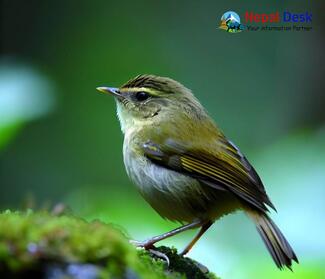Nestled among the towering peaks and lush valleys of Nepal, you'll find a fascinating variety of bird species. One such treasure is the Alpine Leaf Warbler (Phylloscopus occisinensis) – a small yet captivating bird found in this biodiversity hotspot. With its melodious song and vibrant colors, the Alpine Leaf Warbler is a must-see for birding enthusiasts venturing to Nepal. Let us look at its various aspects:
Habitat and Distribution
The Alpine Leaf Warbler predominantly dwells in montane forests, specializing in high-altitude ecosystems between 2,500 and 4,000 meters above sea level. In Nepal, these birds are usually spotted in regions such as Annapurna Conservation Area, Langtang National Park, Makalu Barun National Park, and Sagarmatha National Park. They thrive in mixed forests containing oak, rhododendron, and pine trees.
Physical Appearance and Behavior
The Alpine Leaf Warbler is distinguished by its olive-green plumage above with pale yellow below, punctuated by a distinct yellow supercilium (eyebrow pattern). It possesses a slender frame, measuring around 9-10 cm in length, perfect for maneuvering through dense foliage.
An active and agile bird species, the Alpine Leaf Warbler is typically found flitting through the undergrowth near tree canopies. Its striking songs often echo throughout the mountainside forests – a blend of chirps and trills sung over a wide frequency range. In addition to its delightful melody, this warbler has impressive agility when it comes to feeding on insects like moths or beetles by capturing them mid-flight.
Breeding and Migration Patterns
The breeding season for Alpine Leaf Warbler typically occurs from April to July. In this period, male warblers create intricate cup-shaped nests using leaves, moss, lichen, and other materials found in their environment. After mating, the female lays two to five eggs which are incubated for around 13-15 days before hatching. The young warblers leave the nest after 14 days of being tended to by both parents.
While some Alpine Leaf Warblers remain in Nepal throughout the year, certain populations migrate southward during winter months. These migratory patterns are driven by the need to escape harsh, high-altitude conditions in search of suitable habitats with consistent food resources.
Conservation Efforts
The Alpine Leaf Warbler is currently considered a species of least concern by the International Union for Conservation of Nature (IUCN). However, continued habitat destruction due to rapid deforestation and climate change may result in their decline. In response, the Nepalese government works on preserving valuable ecosystems by establishing protected areas where these enchanting birds can thrive.
In conclusion, the Alpine Leaf Warbler is a remarkable bird that showcases the rich biodiversity found in Nepal's forests. For those who embark on a birdwatching adventure or trek through Nepal’s mountains, don't miss out on this mesmerizing display of avian beauty when you hear its captivating song echoing through the trees.




